Animal Welfare and Dairy Management
Published: January 10, 2019
By: Walter M. Guterbock, DVM, MS
Anacortes, Washington, USA
wmguterbock@earthlink.net
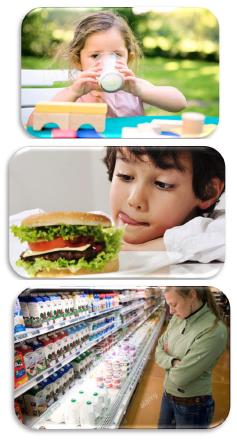
Misconceptions
Animals have to suffer on large confined operations. Abuse is rampant.
Large herds only can exist through widespread use of antibiotics and hormones.
Large farms pollute rivers.
Meat and milk are laden with drug and hormone residues.
Large operations exploit animals and workers for profit.
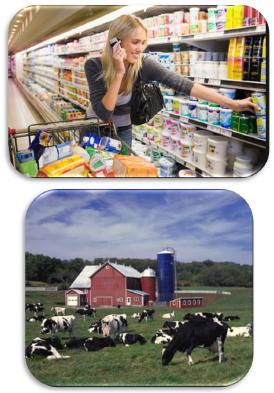
How Can This Happen?
Workers not trained in how to move animals.
Workers not trained in proper animal handling. Heifers not trained to parallel parlor.
No equipment to move downers properly. Facility doesn’t allow loader access.
How Can This Happen?
Workers under time pressure.
Workers are tired and frustrated.
Management tolerated abuse.
NO ONE STOPPED IT!
US Industry’s Response
Animal welfare programs required by milk processors and co-ops. Third party audits.
Publicity showing that we care about our animals and love our cows. Show the benefits of modern facilities and methods.
Main Areas of Concern
Tail docking
Rough animal handling.
Movement and Care of Down Cows. Lameness.
Obstetrics.
Antibiotics and hormones. Biotechnology (rBST, GMO crops)
Issues on the Horizon
Removal of calves from cows.
Individual calf hutches vs. group housing of calves. Access to pasture.
Death rates.
Use of hormones in synch programs.
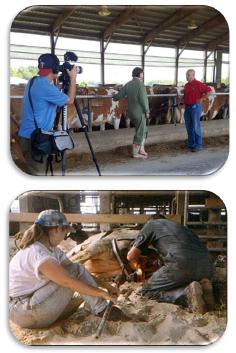
Calm Animal Handling is Safer!
Excited animals are more likely to run over people. Nervous cows more likely to kick.
People running are more likely to fall. Cows under pressure more likely to fall.
We can move animals without shouting, arm waving, hitting, running, or hot shots.
Economic Benefits
Calmer cows, less running, fewer injuries to cows. Better milking and milk letdown.
Cleaner parlor.
Fewer worker injuries by cows. Fewer slips and falls. Lower insurance rates.
It’s the right thing to do!!
Bad Facility Design
Can make humane cow handling more difficult. Make provisions to remove down cows humanely. Wider entry and exit platforms on rotaries.
Minimize twists and turns in cow path. Modify loading chutes.
But you have to work with what you have.
The Bud Box

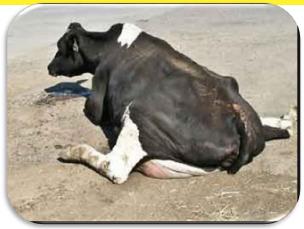
Need the Proper Equipment
Loader/Bobcat access to holding area and exit lanes. Ropes to flip cow into bucket.
Sled for moving down cows.
Soft bedded area for them to lie in. Feed and water for down cows.
Do not use hip clamps to move cows!!
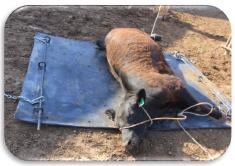
Protocols
For moving cows.
For moving and caring for down cows.
For euthanasia.
For obstetrics and calf care.
For lame cows’ treatment and prevention.
For loading cows into trucks.
Protocols Need to Be
Detailed
Specific
Simple and practical
Used for training
Modified when needed.
Training
Once protocols are in place, all dairy employees who handle cattle need to be trained.
New employees need training.
Refresh training periodically.
Preferably hands-on training, not just a video or a Powerpoint.
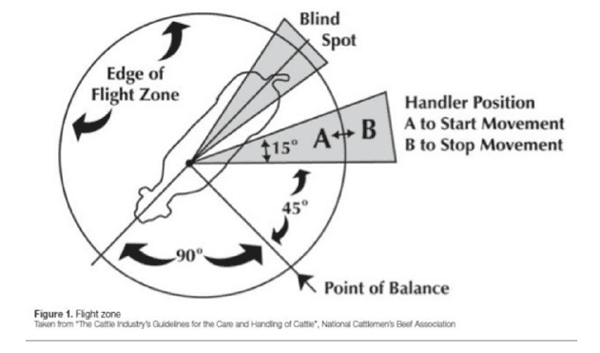

Resources (English and Spanish)
NMPF National Dairy
FARM program:
Merck Dairycare 365: www.dairycare365.com
Good videos on Dairycare365 site.
Monitoring
Watch and listen.
Do you see items that can be used to hit cows? Hotshots?
How do cows respond to you?
Are cows calm in milking barn? How much defecation?
How many broken tails?
Cows don't lie!!!
The culture on the dairy has to encourage people to do right thing!
Sample Mission Statement
We produce high quality food.
We take good care of our animals.
We take good care of our people.
We take good care of the environment.
We are a successful business.
Management must convey the right values through actions!
Do unto others as you would have them do unto you.
Jesus
Hierarchy of Needs
Basics—food, shelter, transportation.
Feeling of being treated fairly.
Family and spiritual.
Recreation, hobbies, fun.
Feeling of belonging, acceptance.
Autonomy. Jobs with little autonomy are more stressful.
Feeling of importance, making a contribution or a difference.

Culture of Safety
Nothing we do is worth getting someone hurt or killed. Machismo is bad.
Provide protective gear needed for safe work.
Guards and interlocks on equipment, restraints, tagout/lockout.
Safe chemical handling.
Make sure first aid supplies and emergency contact information are available to all.
Organization helps avoid crises that put people in danger.
Equipment and facilities need to be maintained.
Strict limits on cell phones.
Immediate correction when dangerous practices are seen.
Culture of Honesty
Openness with employees helps dispel effects of rumors and gossip.
Better to admit mistakes than hide them.
Be willing to hear bad news.
If you cheat your workers, they will get even.
Culture of Cleanliness
A neat, organized work space is safer than a dirty one.
Clean equipment is easier to maintain and makes it easier to see leaks.
We are producing food.
Promotes pride in employees.
Culture of Respect
Greet people by name.
Show interest in their personal life.
Be considerate of family needs.
Praise in public, and often.
Correct in private.
Thank them for what they’ve done.

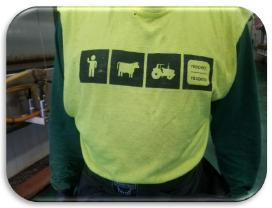
People are the Greatest Asset of the Dairy!!
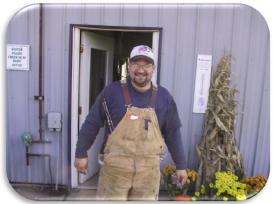
Getting extraordinary results from ordinary people (and cows)!
The Worker Owns the Job!
Manager’s job is to make it possible for employee to do it well. Training
Supplies
Clear goals and expectations Praise and correction
Fair compensation and time off.
The Worker Owns the Job!
Strategy is decided by the boss.
The employee knows the job better than the boss. Detailed procedures may not reflect daily reality.
As long as goals are achieved, give workers some autonomy.
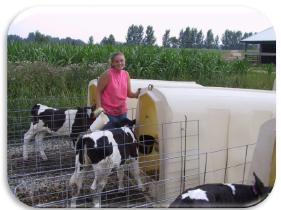
The Job of the Manager is to Help the Employees Do the Work!
Provide a workable schedule.
Provide structure and clear instructions. Needed supplies available.
Equipment works properly. Tolerable working conditions. Safe working environment.
Be fair.
Make It Easier to Do a Good Job!
Facilities make animal sorting and restraint easier.
Vital supplies and equipment available and easy to find. Spares available for key items.
Plan for adverse events: breakdowns, bad weather, power failure, absences.
Suit the Job to Temperament of Worker
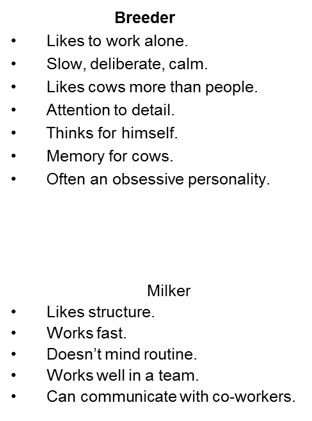
It Must Be Clear
Who is my boss?
What am I responsible for? Who evaluates my work? Whom do I supervise?
To whom can I go for help?
How do I get the supplies I need?
Supervising is a Skill
Good cow people tend to be introverted and asocial.
A good supervisor must communicate and convey that she/he cares. Don’t promote people to their level of incompetence!
Some people are natural leaders, others followers.
Supervision is a Skill II
It may be hard to assert authority over your former buddies. Provide training and feedback to novice supervisors.
Respect the chain of command; don’t undercut your supervisors.
Written Manuals and Job Descriptions
Very important to clarify responsibilities and organizational chart; boss benefits most.
Usually only consulted in a crisis and at evaluation time. Hazard that it also defines what job is not.
You want employees to be flexible and show initiative. What if the employee can’t read?
Who will update them, and when?
When things go wrong
Is it because someone didn’t do what they were supposed to? Did they know they were supposed to?
Did they know how to do it?
Did they have what they needed to do it?
Was it the fault of the employee or the system? Was the employee empowered to get the job done?
When Employees Fail
Rarely because of technical competence.
Usually because of character flaws or interpersonal problems. Once the decision to fire is made, get it over with.
Don’t fire until you have a replacement plan.
What Can Not be Tolerated
Drinking or drunkenness. Drug use or sale.
Abuse of cows.
Abuse of co-workers, Corruption. Fighting.
Dishonesty.
Willful disregard of safety rules. Not caring.
Procedural Drift
Happens everywhere.
New people, outside influences, poor attitudes, conscious decisions. Reinforcement of proper methods must be continuous.
Training has to be repeated.
Be open to suggestions for change.
Trust, but Verify
You have to trust your good people to do their jobs. It is discouraging if you meddle in their area.
But you have to be close enough to see problems. Tough to get it right.
Respect the Chain of Command
If you don’t, your supervisors can’t command the respect of their workers. Your instructions may contradict theirs.
When you see something you don’t like, talk to the supervisor, not the worker. Be friendly, but don’t play favorites.
Listen, but don’t act on complaints until you get the whole story. Default: support the supervisor.
Make your dairy a desirable place to work!!
Your workers will help you with recruitment and training
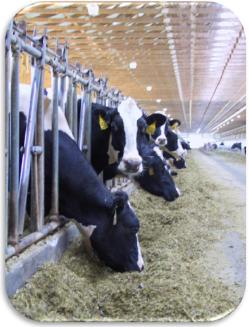
Presented at the 18th MVZ International Congress for Bovine Specialists.
Related topics
Authors:
Join to be able to comment.
Once you join Engormix, you will be able to participate in all content and forums.
* Required information
Would you like to discuss another topic? Create a new post to engage with experts in the community.
Create a post




.jpg&w=3840&q=75)